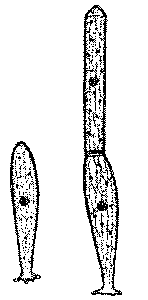
Flicking through various books in a quite unsystematic way I had narrowed it down to two, Characiopsis sp. or Characium sp.

I wasn't particularly confident with either genus but since it turned out that the former has no starch formed, an Iodine solution test should do the trick. So I made a note to get some from work. By the time I had, a second look at the sample revealed some further development. The cells were no longer singular and were in fact two or three cells long; this was a filamentous alga! Further features noted, such as concentric rings around one or two of the cells made me realise this was in fact Oedogonium.
There are over two hundred species in this genus. It is a filamentous type where the cells divide by a characteristic method. It is this division that causes the rib-like bands at the end of the cell. The number of "ribs" present indicates the number of times the cell has divided. Oedogonium produces motile spores and these eventually settle down and germinate to form new plants. It is this stage that I had come across, the so called germlings. They looked peculiar at one end because they have a star-shaped disc or holdfast.

This just goes to show how easily we fall into too speedy an identification. Also how important it is to make observations over a period of time before coming to any hard and fast conclusions. Above all it is but a learning experience and a great deal of fun, and that is what really matters. Oh, this is how it normally looks!

Please report any Web problems
or offer comments to the Micscape Editor,
via the contact on current Micscape Index.
Micscape is the on-line monthly
magazine of the Microscopy UK web
site at Microscopy-UK